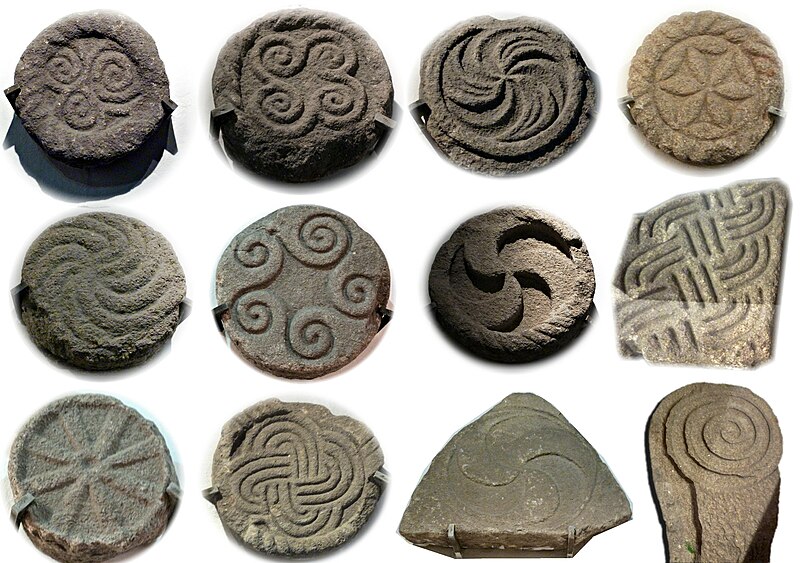Alice C. Linsley
The evidence of artifacts indicates that solar symbolism was pervasive among the R1 peoples of Africa, Eurasia, Anatolia, Slovenia, ancient Gaul, and the British Isles. The Sun was a widely venerated sacred symbol of the High God and His Son.
Here is a description of Messiah as the "true sun" in Gildas' De Excidio et Conquestu Britanniae:
Meanwhile, to the island stiff with frost and cold, and in a far distant corner of the earth, remote from the visible sun, He, the true sun, even Christ, first yields His rays, I mean His precepts. He spread, not only from the temporal firmament, but from the highest arc of heaven beyond all times, his bright gleam to the whole world in the latest days, as we know, of Tiberius Caesar. At that time the religion of Christ was propagated without any hindrance, because the emperor, contrary to the will of the senate, threatened with death informers against the soldiers of that same religion.
The Triglav obelisk of Slovenia appears to be a Messianic image. Here a God-Man is shown wearing the Sun as his crown. The term "Triglav" refers to the concept of a triune Presence, or Trinity. Among the southern Slavs this triune High God was called was Hromi Daba.
Another solar image found widely among the R1 peoples is the 6-prong rosette. It is seen below on one of these 9th century BC artifacts (coin on top right). This ancient symbol has been found from Ethiopia to England and from Pakistan to Galilee. It testifies to the importance of the Sun as a symbol of divine authority. The image was found among the Celts of the northern Iberian Peninsula.
The same image is found on Balkan pottery. Here it appears on 14th-15th century enameled terracotta tableware found at Studenica monastery complex in western Serbia. The rosette is sometimes called "Perun's flower."
These two amulets were discovered in 1985 at the archaeological site of Mehrgarh in Balochistan, western Pakistan. The amulets date to the 3rd millennium B.C. and represent the wheel or solar chariot of the Supreme God.
This 6-prong star or rosette appears on ancient Jewish ossuaries. This was the solar boat of the Creator, the vehicle of Light that carries the dead to the place of rest until the Last Day.
The 2,000-year-old ossuary shown above belonged to a daughter of the Caiaphas family of high priests. It is marked with the 6 pointed star and has an Aramaic inscription that says, “Miriam Daughter of Yeshua Son of Caiaphas, Priests of Ma’aziah from Beth Imri.” The inscription dates to the time of the Second Temple.
The six prong star is also found on the ossuary of Joseph Caiaphas, the high priest (shown below).
The same symbol is found on this wooden entrance in Romania.
These two amulets were discovered in 1985 at the archaeological site of Mehrgarh in Balochistan, western Pakistan. The amulets date to the 3rd millennium B.C. and represent the wheel or solar chariot of the Supreme God.
This 6-prong star or rosette appears on ancient Jewish ossuaries. This was the solar boat of the Creator, the vehicle of Light that carries the dead to the place of rest until the Last Day.
 |
| Stone ossuary chest used for secondary burial of bones |
The six prong star is also found on the ossuary of Joseph Caiaphas, the high priest (shown below).
The merkaba as chariot spokes within a circle appears to be an Iron Age version of Ra's solar boat. The Creator was believed to mount the sun as a chariot and ride the winds, making His circuit. This speaks about God's sovereignty over all the Earth.
It is likely that this same image appeared on the Ark of the Covenant. In the Ethiopian Church a replica of the Ark (called Tabot) is decorated at the center with the 6-prong star inside a circle.
The same image appears on a tomb at Banais, Israel, one of the sources of the Jordan river. There is a large cave and various archaeological sites with pools of water running beneath and large cliffs rising above.
The symbol appears on the top and sides of the Magdala Stone (below) which was found in the western shores of the Sea of Galilee in September 2009.
The symbol appears on the top and sides of the Magdala Stone (below) which was found in the western shores of the Sea of Galilee in September 2009.











.jpg)









2 comments:
The two amulets found in 1985 resemble wheels. I am remembering a song we sang in the Black community describing Yeshua as my wheel in the middle of a wheel. I know I'm off topic, but had to express this somewhere.
Interesting! Perhaps the wheels within wheels relates to Ezekiel's vision in Ezekiel 1:1-48:22?
Post a Comment